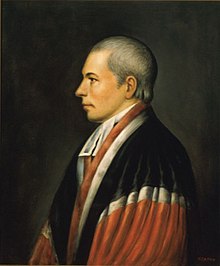William Paterson (judge)
| William Paterson | |
|---|---|
 |
|
| Associate Justice of the Supreme Court of the United States | |
|
In office March 4, 1793 – September 9, 1806 |
|
| Appointed by | George Washington |
| Preceded by | Thomas Johnson |
| Succeeded by | Henry Livingston |
| 2nd Governor of New Jersey | |
|
In office October 29, 1790 – March 30, 1793 |
|
| Preceded by | Elisha Lawrence (Acting) |
| Succeeded by | Thomas Henderson (Acting) |
|
United States Senator from New Jersey |
|
|
In office March 4, 1789 – November 13, 1790 |
|
| Preceded by | Seat established |
| Succeeded by | Philemon Dickinson |
| Attorney General of New Jersey | |
|
In office 1776–1783 |
|
| Governor | William Livingston |
| Preceded by | Position established |
| Succeeded by | Joseph Bloomfield |
| Personal details | |
| Born |
December 24, 1745 County Antrim, Ireland (now United Kingdom) |
| Died |
September 9, 1806 (aged 60) Albany, New York, U.S. |
| Political party | Federalist |
| Spouse(s) |
Cornelia Bell (m. 1779; her death 1783) Euphemia White (m. 1785; his death 1806) |
| Parents | Richard Paterson |
| Alma mater | Princeton University (BA, MA) |
William Paterson (December 24, 1745 – September 9, 1806) was a New Jersey statesman, a signer of the U.S. Constitution, and Associate Justice of the United States Supreme Court, who served as the second governor of New Jersey, from 1790 to 1793.
William Paterson was born December 24, 1745 in County Antrim, now in Northern Ireland, to Richard Paterson. Paterson moved to what is now the United States at age 2, and entered the College of New Jersey (now Princeton University) at age 14. After graduating, he studied law with the prominent lawyer and was admitted to the bar in 1768. He also stayed connected to his alma mater and helped found the Cliosophic Society with Aaron Burr.
Paterson was selected as the Somerset County delegate for the first three provincial congresses of New Jersey, where, as secretary, he recorded the 1776 New Jersey State Constitution. After Independence, Paterson was appointed as the first Attorney General of New Jersey, serving from 1776 to 1783, maintaining law and order and establishing himself as one of the state's most prominent lawyers. He was sent to the 1787 Philadelphia Convention in Philadelphia, Pennsylvania where he proposed the New Jersey Plan for a unicameral legislative body with equal representation from each state. After the Great Compromise (for two legislative bodies: a Senate with equal representation for each state, and a House of Representatives with representation based on population), the Constitution was signed.
...
Wikipedia
